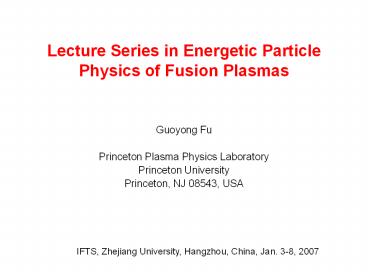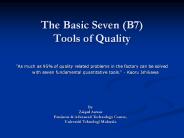Lecture Series in Energetic Particle Physics of Fusion Plasmas - PowerPoint PPT Presentation
1 / 29
Title:
Lecture Series in Energetic Particle Physics of Fusion Plasmas
Description:
F. Zonca, F. Romanelli, G. Vlad and C. Kar 1995, Phys. Rev. Lett. 74, 698 ... Particle/MHD hybrid model. Use M3D code ... XMHD Model. Experimental observation ... – PowerPoint PPT presentation
Number of Views:58
Avg rating:3.0/5.0
Title: Lecture Series in Energetic Particle Physics of Fusion Plasmas
1
Lecture Series in Energetic Particle Physics of
Fusion Plasmas
- Guoyong Fu
- Princeton Plasma Physics Laboratory
- Princeton University
- Princeton, NJ 08543, USA
IFTS, Zhejiang University, Hangzhou, China, Jan.
3-8, 2007
2
A series of 5 lectures
- (1) Overview of Energetic Particle Physics in
Tokamaks (today) - (2) Tokamak equilibrium, shear Alfven wave
equation, Alfven eigenmodes (Jan. 4) - (3) Linear stability of energetic
particle-driven modes (Jan. 5) - (4) Nonlinear dynamics of energetic
particle-driven modes (Jan. 6) - (5) Summary and future direction for research in
energetic particle physics (Jan. 8)
3
Outline
- Saturation mechanism
- Single mode saturation bump-on-tail problem
- Multi-mode problem
- Hybrid simulation of fishbone instability
- Summary
4
Destabilize shear Alfven waves via wave-particle
resonance
- Destabilization mechanism (universal drive)
- Wave particle resonance at
- For the right phase, particle will lose energy
going outward and gaining energy going inward. As
a result, particles will lose energy to waves. - Energetic particle drive
Spatial gradient drive
Landau damping Due to velocity space gradient
5
TAE Stability energetic particle drive and
background dampings
- Energetic particle drive
- Dampings
- Ion and electron Landau damping, collisional
damping, continuum damping, radiative damping
due to kinetic Alfven waves - Drive gt damping for instability
- G.Y.Fu and J.W. Van Dam, Phys. Fluids B1, 1949
(1989). - M.N. Rosenbluth, H.L. Berk, J.W. Van Dam and D.M.
Lindberg 1992, Phys. Rev. Lett. 68, 596 - R.R. Mett and S.M. Mahajan 1992, Phys. Fluids B
4, 2885
6
First observation of TAE in TFTR
.
K.L. Wong, R.J. Fonck, S.F. Paul, et al. 1991,
Phys. Rev. Lett. 66, 1874
7
Example of EPM fishbone instability
Mode structure is of (m,n)(1,1) internal
kink Mode is destabilized by energetic
trapped particles Mode frequency is comparable
to trapped particles precessional drift
frequency
K. McGuire, R. Goldston, M. Bell, et al. 1983,
Phys. Rev. Lett. 50, 891 L. Chen, R.B. White and
M.N. Rosenbluth 1984, Phys. Rev. Lett. 52, 1122
8
Bump-on-tail problem definition
H.L. Berk and B.N. Breizman 1990, Phys. Fluids B
2, 2235
9
Bump-on-tail problem saturation mechanism
- We first consider case of no source/sink and no
damping. The instability then saturates at
The saturation is due to wave-particle trapping.
The instability saturates when the distribution
is flattened at the resonance region (width of
flattened region is on order of
10
Bump-on-tail problem saturation with damping,
source and sink
- Collisions tend to restore the original unstable
distribution. Balance of nonlinear flattening and
collisional restoration leads to mode saturation.
It can be shown that the linear growth rate is
reduced by a factor of . Thus, the
mode saturates at
H.L. Berk and B.N. Breizman 1990, Phys. Fluids B
2, 2235
11
H.L. Berk et al, Phys. Plasmas 2, 3007 (1995).
12
Transition from steady state saturation to
explosive nonlinear regime
B.N. Breizman et al Phys. Plasmas 4, 1559 (1997).
13
Hole-clump creation and frequency chirping
- For near stability threshold and small collision
frequency, hole-clump will be created due to
steepening of distribution function near the
boundary of flattening region. - As hole and clump moves up and down in the phase
space of distribution function, the mode
frequency also moves up and down.
H.L. Berk et al., Phys. Plasma 6, 3102 (1999).
14
(No Transcript)
15
(No Transcript)
16
Experimental observation of frequency chirping
M.P. Gryaznevich et al, Plasma Phys. Control.
Fusion 46 S15, 2004.
17
Saturation due to mode-mode coupling
- Fluid nonlinearity induces n0 perturbations
which lead to equilibrium modification, narrowing
of continuum gaps and enhancement of mode
damping. - D.A. Spong, B.A. Carreras and C.L. Hedrick 1994,
Phys. Plasmas 1, 1503 - F. Zonca, F. Romanelli, G. Vlad and C. Kar 1995,
Phys. Rev. Lett. 74, 698 - L. Chen, F. Zonca, R.A. Santoro and G. Hu 1998,
Plasma Phys. Control. - Fusion 40, 1823
- At high-n, mode-mode coupling leads to mode
cascade to lower frequencies via ion Compton
scattering. As a result, modes saturate due to
larger effective damping.
T.S. Hahm and L. Chen 1995, Phys. Rev. Lett. 74,
266
18
.
Multiple unstable modes can lead to resonance
overlap and stochastic diffusion of energetic
particles
H.L. Berk et al, Phys. Plasmas 2, 3007 (1995).
19
Nonlinear Hybrid Simulation of Fishbone
instability
- Particle/MHD hybrid model
- Use M3D code
- Observed dynamic distribution flattening as mode
frequency decreases.
G.Y. Fu et al, Phys. Plasmas 13, 052517 (2006)
20
M3D Code
- M3D is a 3D extended nonlinear MHD code with
multiple level of physics - resistive MHD
- two fluids
- Particle/MHD hyrid
21
M3D XMHD Model
22
(No Transcript)
23
Experimental observation of fishbone instability
in PDX
24
Excitation of Fishbone at high bh
25
Mode Structure Ideal Kink v.s. Fishbone
26
Nonlinear evolution of mode structure and mode
amplitude
27
Saturation amplitude scale as square of linear
growth rate
28
Simulation of fishbone shows distribution
fattening and strong frequency chirping
distribution
29
Summary
- Single mode saturates due to wave-particle
trapping or distribution flattening. - Collisions tend to restore original unstable
distribution. - Near stability threshold, nonlinear evolution can
be explosive when collision is sufficiently weak.
- Mode-mode coupling can enhance damping and induce
mode saturation. - Multiple modes can cause resonance overlap and
enhance particle loss.































